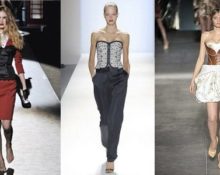There are many rumors and prejudices surrounding corsets. Nowadays, many people consider them almost instruments of torture. However, the real story is surprisingly much less bloodthirsty and not so replete with women’s suffering. At least in terms of corsets. Today I will tell you about their real evolution.
Long before our era
Many people mistakenly believe that this item of clothing appeared around the 16th-17th century. To some extent, this is true. Corsets as we know them today were created in modern times. However, they have much older ancestors.
The earliest examples date back to 2000-1600 BC. Ancient Egypt still existed then. However, in those days, “corsets” were worn not under clothes, but on top of them and served only as decoration. They did not reduce the waist or straighten the posture, and in general they were made of fabric.

@Wikimedia
The word itself was first mentioned around 1300. It is derived from the Latin “corpus”, that is, “body”.Another version is from the Old French "cors". However, at that time this word was used to describe an element of clothing that was not quite familiar to us. At that time it was used to designate the corsage - the part of the dress that covers the bust.
Not for the waist at all
The appearance of the familiar corset is associated with the names of Catherine de Medici or Joan of Portugal. Both queens in the 16th century may have introduced fashion for this item of clothing. However, they did not wear it at all to acquire a wasp waist. In fact, the corset was only supposed to maintain posture and look beautiful. Metal inside the structure was rare and was most often replaced by plastic whalebone.

@Wikimedia
In the 17th century the trends did not change. Little attention was paid to the beauty of the figure among the aristocracy. The corset served only as a basis for jewelry, a beautiful detail in lush costumes. True, Russians visiting European friends mistook corsets for the ribs of their ladies.
The same fashion continued into the 18th century. Back then, ladies had to sit with their backs straight for many hours at receptions, and even wear incredibly heavy, voluminous skirts. So the corset basically helped maintain the girl's posture and the pile of extra fabric on her dress.

@englishhistoryauthors
When everything went downhill
Already at the end of the 18th century, the importance of the corset began to be lost. Fluffy dresses went out of fashion, replaced by lighter and calmer clothes. The function of beautiful decoration fades into the background. Already at the beginning of the 19th century, the corset began to be actively used to change the figure. Its conical shape gives way to an hourglass shape. In addition, it goes beyond the culture of the nobility - even ordinary people begin to wear such clothes.

@Metropolitan Museum of Art
The fashion for a “wasp waist” and “correct silhouette” is becoming more and more radical. In the Edwardian era they even created corsets for the entire body. At the same time, both women and doctors begin to actively protest against this element of the wardrobe. In particular, due to the fact that it is harmful to health. Namely, it deforms organs and bones. But is this really so?
Myths and reality
Many have seen crazy photos of girls of that time, whose waist could be completely wrapped around one hand. Amazing sight, isn't it? However, this is nothing more than a fake. Yes, yes, in those days they knew how to fake photos without computers and Photoshop. In addition, in order for the body to actually become deformed from wearing a corset, it had to be kept in place since childhood.
However, it should be noted that although the problem was exaggerated, it still existed. Yes, the girls did not shrink their waists to an unrealistic 40 centimeters. But in general they were under pressure, and this affected my health. Besides, many people actually wore this item since childhood. Although not as often as is believed.
Modern people demonize this element of clothing too violently. It was somewhat problematic before, but today there are no such strict fashion rules. If you wear today's corset wisely, nothing bad will happen. This is again just a beautiful accessory, and not an instrument of torture.


 1
1





